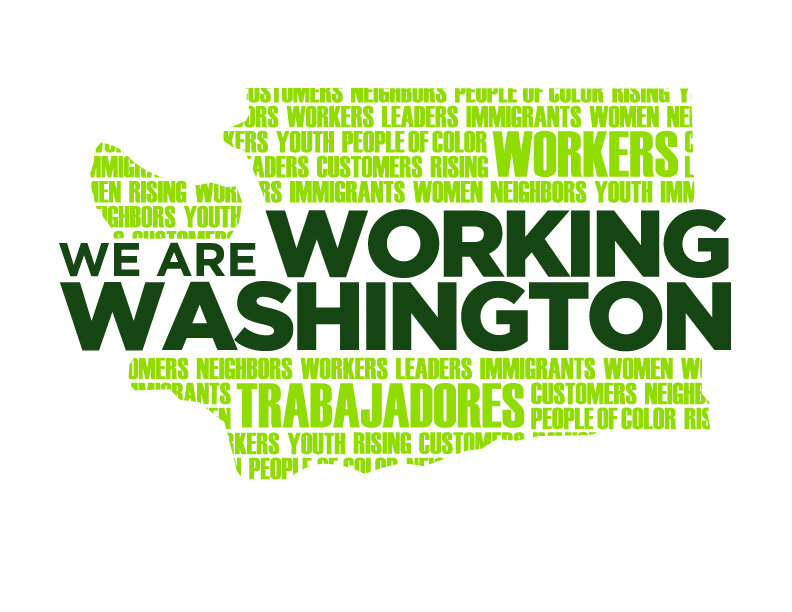Outdated overtime rules leave 250,000+ salaried workers in Washington working extra hours without extra pay, losing out on 34% of time & money they’re due
Time is money, and employers are taking both — to the tune of $4 billion worth from salaried workers in our state this year alone.
Take action!
🧠 Learn more about the campaign to restore overtime rights.
📝Sign our petition to L&I to ensure nobody has to work without getting paid for it.
💬Answer a few questions and tell us about your experiences as an "overtime exempt" worker.
That startling figure is an estimate of what is lost by salaried workers who have been working more and more hours — without getting paid for it. That’s because our state’s overtime rules have fallen so far behind the times that employers can get away with not paying workers an extra dime when they work more than 40 hours a week, as long as they classify the worker as “exempt” from overtime and pay them a salary of just $24,000/year.
When employers don’t have to pay for employees’ time, that time usually gets treated like it doesn’t count. Research has backed that up, with surveys finding that salaried workers put in an average of 49 hours a week, but vanishingly few get paid anything extra when they work extra hours over 40.
Washington State L&I is in the midst of a process to update our state’s out-of-date overtime rules, and Working Washington members are calling on L&I to update their rules so that anyone paid less than triple the minimum wage (about $75,000/year) gets time-and-a-half pay for overtime when they work over 40 hours a week. This is about how it worked when the rules were last updated in the mid-1970s, adjusted for changes in the wage market of course. Back then, about 60% of salaried workers got overtime pay when they worked over 40 hours a week. Now, only about 8% do.
Restoring overtime protections and returning this $4.2 billion of time to Washington’s salaried workers will boost productivity, expand opportunity, and help workers bring their jobs, lives, and families back into balance. To the extent that restoring overtime rights raises the take-home pay of salaried workers, we know from experience with minimum wage increases that this money goes right back into the economy, especially because it will be paid out to workers here in Washington instead of being deposited in distant corporate bank accounts. And to the extent that restoring overtime rights means less time at work for salaried workers, that translates to more parents who have time for their children, more neighbors who have time for their communities, and more people who have time to pursue their dreams.
How we calculated the figure of $4.2 billion of lost time and money
Here’s how the math lays out:
Salaried employees in the U.S. report working an average of 49 hours a week. But if you’re overtime-exempt, you don’t get paid an extra dime for all the extra hours over 40. (Source: Gallup)
If paid at time-and-a-half, those 9 extra hours of unpaid work would be worth a 34% premium on top of a salaried worker’s full-time pay for 40 hours. Nine hours at time-and-a-half is the equivalent of 13.5 hours at straight time, which represents an additional 34% over 40 hours.
We’re calling on the state to update the rules to ensure that anyone paid less than about $75,000 a year gets time-and-a-half pay when they work more than 40 hours a week, which about how it worked when the rules were last updated in the mid-1970s, adjusted for changes in the wage market of course. (Historic data has been compiled by L&I site; the threshold for overtime exemption 1975 was $250/week, approximately triple the minimum wage at the time. At that time, more than 60% of salaried workers got overtime when they worked extra hours over 40 in a week.)
The average worker directly affected by restoring overtime protections from the current $24,000 level to the $75,000 level is paid a salary of about $50,000, and loses $16,875 worth of time & money — per year. The average affected worker is paid halfway between $24,000 and $75,000, or about $50,000 a year. Applying the 34% figure of lost time and money to that $50,000 salary adds up to $16,875 a year in time and money taken from the average affected worked without compensation.
A recent data review suggests that there are approximately 250,000 salaried workers in our state affected by our out-of-date overtime threshold. (Source: The Economic Policy Institute has found that about 234,000 salaried workers in Washington are paid less than $49,000 a year. Obviously there are substantially more workers than that paid less than $75,000, but we don’t have a solid estimate for the number of salaried workers paid below the figure, so we chose to work with this extremely conservative approximation.)
The average loss of $16,875 of time and money a year for each of 250,000+ workers adds up to $4.2 billion in time and money taken from salaried workers in our state each year by employers who take advantage of our out-of-date overtime exemptions.
Note that while this long overdue update to overtime rules would have a huge impact on workers’ lives, we don’t anticipate that employers would actually put $4.2 billion more into their payrolls. Rather, a huge portion would be returned to workers in the form of time they’d have to live their lives instead of spending at work. Because once workers’ time has a price again, employers will take less of it.

